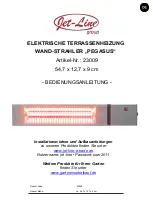
lp-441 Rev. 004 Rel. 000 Date 7.2.21
15
To avoid water damage or scalding due to relief valve operation:
•
Discharge line must be connected to relief valve outlet and
run to a safe place of disposal. Terminate the discharge line
in a manner that will prevent possibility of severe burns or
property damage should the relief valve discharge.
•
Discharge line must be as short as possible and the same
size as the valve discharge connection throughout its entire
length.
•
Discharge line must pitch downward from the valve
and terminate at least 6” above the floor drain, making
discharge clearly visible.
•
The discharge line shall terminate plain, not threaded, with
a material serviceable for temperatures of 375
o
F or greater.
•
Do not pipe discharge to any location where freezing could
occur.
•
No valve may be installed between the relief valve and
heater or in the discharge line. Do not plug or place any
obstruction in the discharge line.
•
Test the operation of the relief valve after filling and
pressurizing the system by lifting the lever. Make sure the
valve discharges freely. If the valve fails to operate correctly,
immediately replace with a new properly rated relief valve.
•
Test T&P valve at least once annually to ensure the waterway
is clear. If valve does not operate, turn the heater “off” and
call a plumber immediately.
•
Take care whenever operating relief valve to avoid scalding
injury or property damage.
FAILURE TO COMPLY WITH THE ABOVE GUIDELINES COULD
RESULT IN FAILURE OF RELIEF VALVE OPERATION, RESULTING
IN POSSIBILITY OF SUBSTANTIAL PROPERTY DAMAGE, SEVERE
PERSONAL INJURY, OR DEATH.
RE-INSPECTION OF T&P RELIEF VALVES: T&P valves should be
inspected AT LEAST ONCE EVERY THREE YEARS, and replaced if
necessary,
by a licensed plumbing contractor or qualified service
technician to ensure that the product has not been affected by
corrosive water conditions and to ensure that the valve and
discharge line have not been altered or tampered with illegally.
Certain naturally occuring conditions may corrode the valve and
its components over time, rendering the valve inoperative. Such
conditions can only be detected if the valve and its components
are physically removed and inspected.
Do not attempt to conduct
an inspection on your own.
Contact your plumbing contractor
for a re-inspection to assure continued safety.
FAILURE TO RE-INSPECT THE T&P VALVE AS DIRECTED COULD
RESULT IN UNSAFE TEMPERATURE AND/OR PRESSURE BUILD-
UP WHICH CAN RESULT IN PROPERTY DAMAGE, SERIOUS
PERSONAL INJURY, OR DEATH.
F. Scalding
This water heater can deliver scalding water. Be careful whenever
using hot water to avoid scalding injury. Certain appliances such as
dishwashers and automatic clothes washers may require increased
water temperatures. By setting the thermostat on this heater
to obtain the increased water temperature required by these
appliances you may create the potential for scald injury.
To protect against injury, install a mixing valve in the water system.
This valve will reduce point of use discharge temperatures by mixing
cold and hot water in branch supply lines. Such valves are available
from your local plumbing supplier.
Table 5 details the relationship of water temperature and time with
regard to scald injury and may be used as a guide in determining the
safest water temperature for your applications.
An ASSE 1017 or ASSE 1070 temperature limiting or mixing valve is
recommended in installations servicing disabled or elderly persons,
or children. Mixing valves do not eliminate the risk of scalding.
To avoid scalding:
•
Set the water heater set point temperature as low as possible.
•
Feel water before bathing or showering.
•
If thermostatic valves are required, use devices specifically
designed for such purpose. Install these devices in accordance
with instructions provided by the manufacturer.
Failure to install a temperature limiting or mixing valve and follow
these instructions could result in property damage, severe personal
injury, or death due to scalds.
Approximate Time / Temperature Relationships in Scalds
120
o
F
More than 5 minutes
125
o
F
1 1/2 to 2 minutes
130
o
F
About 30 seconds
135
o
F
About 10 seconds
140
o
F
Less than 5 seconds
145
o
F
Less than 3 seconds
150
o
F
About 1 1/2 seconds
155
o
F
About 1 second
Table 5 - Approximate Time / Temperature Relationships in Scalds
The water heater must be full of water and the system fully purged
BEFORE powering the water heater. When filling the water heater,
open a hot water tap to release air in the tank and piping. All air
has been purged from the system when water runs freely from the
faucets.
Applying power to the water heater when it is not full of water will
damage the heat exchanger, and could result in property damage,
serious personal injury, or death. Such damages ARE NOT covered by
water heater warranty.
• Make certain the
drain valve is
completely closed.
• Open the shut-off
valve in the cold
water supply line.
• Open the hot water
faucets to allow air
to vent from the
heater and piping.
• Allow sufficient
time for the heater
to completely fill
with water.
G. Filling the Heater
















































